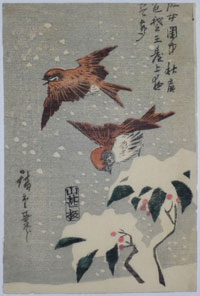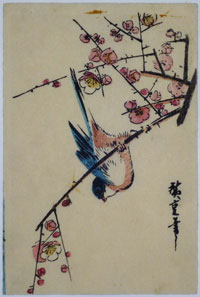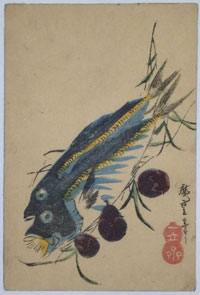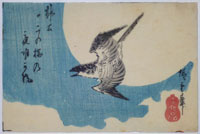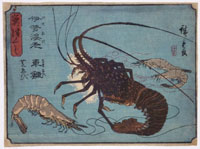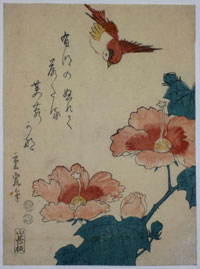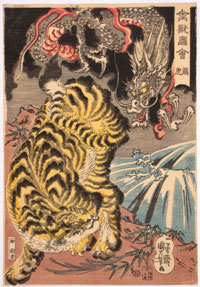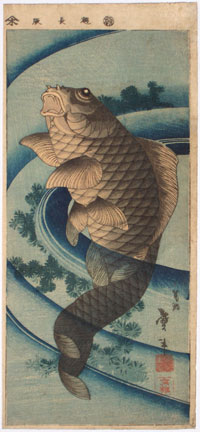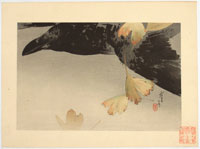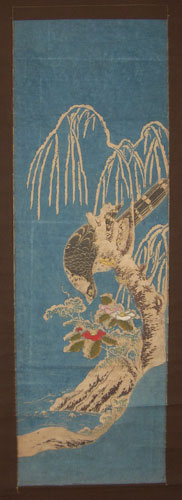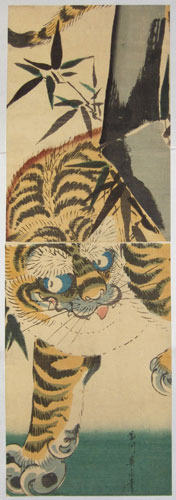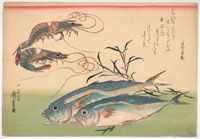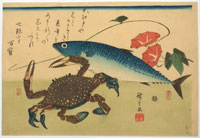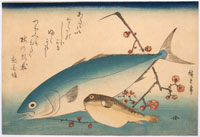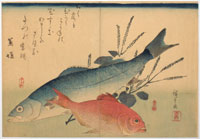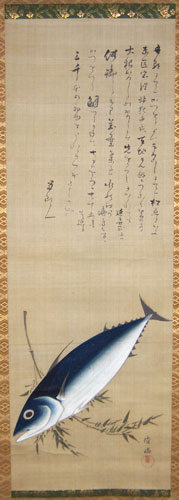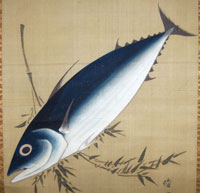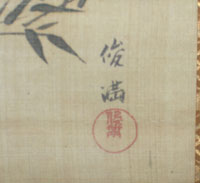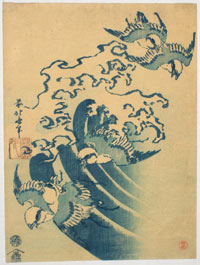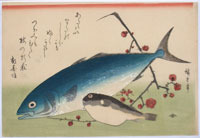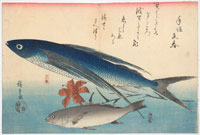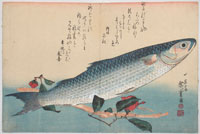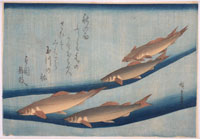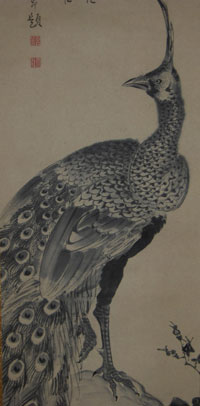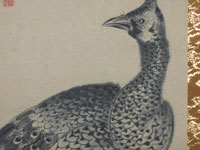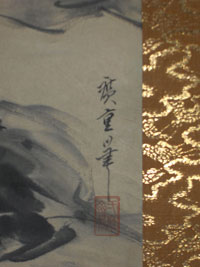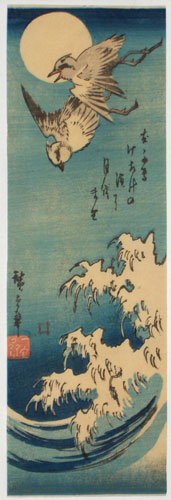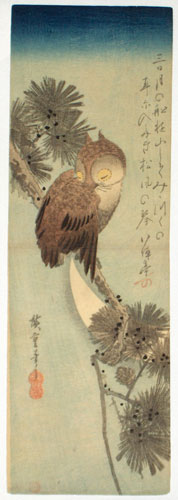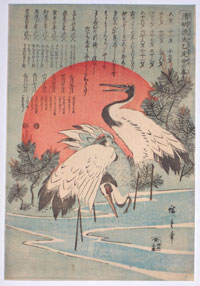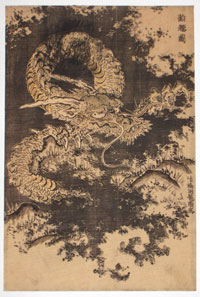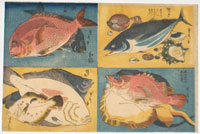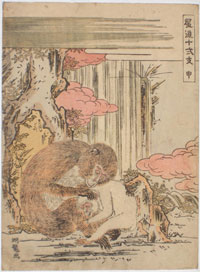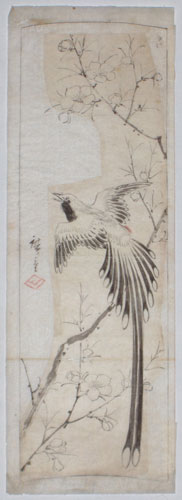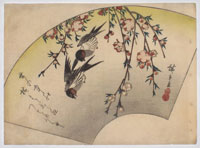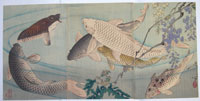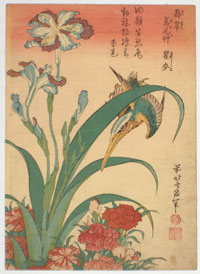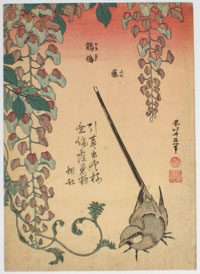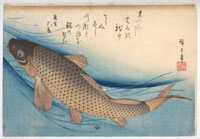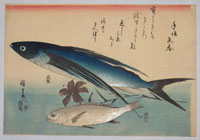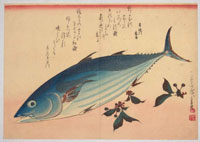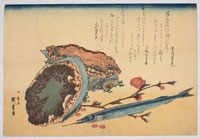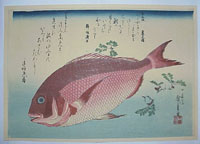/category/flora-and-fauna/page/3/
Utagawa HIROSHIGE II ( SHIGENOBU ) (1826-1869)
Click here to view image full size.
A quarter-block, 6.5 x 4.25 in; 16.5 x 11 cms, print showing two tree sparrows flying in snow over snow-covered bushes. Published by Yamashiroya Kambei (?) c late 1840s. Ex collection Paul-Louis de la Noe, 1879-1919, ( an acquaintance of the Goncourt brothers, Bing and Hayashi ). Possibly unique.
Very good impression, colour and condition. Signed Hiroshige hitsu.
Status: Sold
Utagawa HIROSHIGE (1797-1858)
Click here to view image full size.
A quarter-block, 6.5 x 4.25 in; 16.5 x 11 cms, print showing a titmouse perched on a cherry blossom branch. Published c late 1830s. Ex collection Paul-Louis de la Noe, 1879-1919, ( an acquaintance of the Goncourt brothers, Bing and Hayashi ). Probably unique.
Very good impression, colour and condition. Signed Hiroshige hitsu.
Status: Sold
Utagawa HIROSHIGE (1797-1858)
Click here to view image full size.
A quarter-block, 6.5 x 4.25 in; 16.5 x 11 cms, print showing two horse-mackerel and baby aubergines. Published c late 1830s. Ex collection Paul-Louis de la Noe, 1879-1919, ( an acquaintance of the Goncourt brothers, Bing and Hayashi ). Probably unique.
Very good impression, colour and condition. Signed Hiroshige hitsu.
Status: Sold
Utagawa HIROSHIGE (1797-1858)
Click here to view image full size.
A quarter-block, 4.25 x 6.5 in; 11 x 16.5 cms, print showing a cuckoo flying against a full moon. This bird is usually associated with the moon and is a harbinger of spring. Published late 1830s. Ex collection Paul-Louis de la Noe, 1879-1919, ( an acquaintance of the Goncourt brothers, Bing and Hayashi ). Probably unique.
Very good impression, colour and condition. Signed Hiroshige hitsu.
Status: Sold
Utagawa HIROSHIGE (1797-1858)
Click here to view image full size.
Sakana zukushi, A Fish Series, this design showing Ise-ebi, Kuruma-ebi and Shima-ebi, Lobster [ with roe ], Prawn and Shrimp. A half-block set of the utmost rarity. Indeed, this might be the only recorded example. One other design from the same set is illustrated in Hiroshige, The Albuquerque Museum, 1983, no. 327. Published c late 1830s. Ex collection Paul-Louis de la Noe, 1879-1919, ( an acquaintance of the Goncourt brothers, Bing and Hayashi ).
Fine impression and colour. Slight edge soil with small repairs to to top left and right corners, otherwise very good condition. Signed Hiroshige ga.
Status: Sold
Utagawa HIROSHIGE II ( SHIGENOBU ) (1826-1869)
Click here to view image full size.
A half block, 8.5 x 6.5 in; 22 x 16 cms, print showing a tree sparrow and hibiscus. From a series of prints by the same publisher, Yamashiroya Kambei (?) published 1851-53 ( Kunugasa and Murata seals ). Probably Hiroshige IIs best set in this genre. Ex collection Paul-Louis de la Noe, 1879-1919, ( an acquaintance of the Goncourt brothers, Bing and Hayashi ).
Very good impression and colour. Very minor soil. Signed Shigenobu hitsu.
Status: Sold
Isoda KORYUSAI (1735-1790)
Click here to view image full size.
An hashira-e showing nine cranes, a pine tree and the rising sun. A triple talisman of good luck. The tancho ( “red crest” ) Japanese Crane, Grus japonensis, is the second rarest crane in the world, migrating to East Asia in the fall to spend the winter. There is also a resident flock in Hokkaido. Much loved by the Japanese, the crane was a symbol of luck, longevity and fidelity. Rare: Another impression is illustrated in Jacob Pins, The Japanese Pillar Print, V & A, 1982, no. 518 ( which is also illustrated in the V & A Museum catalogue, The Floating World Japanese Popular Prints 1700-1900, 1973, no. IV8 ). Published c. 1770. Koryusai was probably the most prolific designer of pillar prints, although he designed few kacho-e. Ex collection Seisuke Ikeda, 11 -12th April, 1910.
Very good impression. Good colour. Slight fold marks ( as usual ) but generally good condition for a pillar print. Signed Koryusai ga.
Status: Sold

Click here to view image full size.
Utagawa KUNIYOSHI (1797-1861)
Click here to view image full size.
A tiger and dragon from a rare series Kinju zue, “Drawings of Birds and Beasts.” The set of at least five prints published by Joshuya Kinzo, 1837. Although rare, there are different states of the prints from this set, some having yellow cartouches, others red and uncoloured ( as here ). This design is also known with other colour variations.
Very good impression, colour and condition. Signed Ichiyusai Kuniyoshi ga.
Status: Sold
Katsushika TAITO II (act. c. 1810-1853)
Click here to view image full size.
A carp swimming upwards amongst water plants. Taito designed a number of prints, of which this is one, with an ishizuri-e panel at the left. This is normally cut off ( as here ) and certainly adds nothing to the composition. This design must have been popular as there are a number of different states with different blocks for the water: As here and V & I, Estampes Japonaises, Tomes IV, VI, 1973, pl. LXIX, p. 222; Eight Hundred Years of Japanese Printmaking, Carnegie Institute, 1977, no. 346, p. 87 ( with ishizuri panel ), and there is a copy from completely new blocks. Published by Echigoya Chohachi, c. 1848.
Very good impression and colour. Minor soil. Signed Katsushika Taito fude.
Status: Sold
Watanabe SEITEI ( SHOTEI ) (1851-1918)
Click here to view image full size.
A crow in flight with falling ginko leaves from a set of 22 prints Nijuni kacho published 1916 by Okuro Yasugoro. This being the best design from the set.
Fine impression, colour and condition. These prints were published on heavy paper and the early printings must have the large seal bottom right corner. Signed Seitei.
Status: Sold
Kakemono-e ISHIZURI-E (c. late 18th century)
Click here to view image full size.
A falcon perched on a tree trunk above flowering camellias and a stream. These kakemono-e lie somewhere between prints and paintings. The actual technique employed seems to have involved pressing dampened paper into engraved wood. The pigment is then applied to the raised areas; the print then being laid onto thicker paper and pressed home giving a crinckley surface. They have traditionally been ascribed to Koryusai although examples are known with other signatures. Another example of this design was in the Vever collection, Sothebys, Part 1, 26/3/1974, no. 88, p. 69 where Jack Hillier states: ?The kakemono-e are however extraordinary technical and artistic creations, and the present specimen is one of the finest of the designs, comparable to the famous ?White Falcon? in the AIC ( Harunobu, etc., No. 181, p. 271 ).? ( That example appears to have been badly cut at the bottom. ) 35.5 x 11.5 inches, 90 x 29 cms. Mounted as a painting with rollers and box. Excessively rare.
Status: Sold
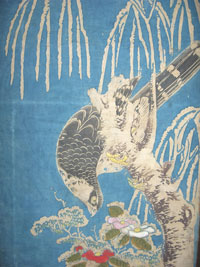
Click here to view image full size.
Kikugawa EIZAN (1787-1867)
Click here to view image full size.
A kakemono-e ( vertical diptych ) showing a tiger peering round a giant bamboo. Although Toyohiro and Toyokuni I produced kakemono-e during the 1800-1804 period, Eizan is generally identified with the format and published many during 1804-1817. The style used borrows from Korean paintings of tigers. No publisher’s seal, c.1804-1817. Another impression illustrated in Ukiyo-e no bi, nishiki-e no keifu, Yamaguchi Prefecture Municipal Museum, n.d., p.84/85.
Good impression. Very good colour and condition with the sheets separated to join accurately. Signed Kikukawa Eizan hitsu.
Status: Sold
Ichiryusai HIROSHIGE (1797-1858)
Click here to view image full size.
Aji, horse-mackerel ( Caranx trachurus ) and kuruma-ebi, prawns, from the first series of fish published by Eijudo, c.mid 1830’s ( although this design always lacks publisher’s seal ). Poem by Toshinoya Tomiharu.
Very good impression. Fine colour. One small thinned area, otherwise exceptional condition with extra paper all round. Signed Ichryusai Hiroshige ga.
Status: Sold
Ichiryusai HIROSHIGE (1797-1858)
Click here to view image full size.
Kani, crab, Charybois and saba, mackerel ( Scomber Japonicus ) together with morning glory. From the second series of fish published by Yamasho, c.1840-42. No publisher’s seal although later editions have the seal of Marujin who presumably bought the blocks and republished the set. Poem by Shichichintei Mampo.
Fine impression of the first edition. Fine colour. Small mark, otherwise fine impression. Full size with extra paper all round. Provenance: Ex Hayashi, Vever and Pulverer collections; the latter seal au verso. Signed Hiroshige ga.
Status: Sold
Ichiryusai HIROSHIGE (1797-1858)
Click here to view image full size.
Inada, yellow tail or amberjack ( Seriola quinqueradiata ) and fugu, blow fish or puffer ( Fugu pardalis ) with plum blossom from the second series of fish published by Yamasho, c.1840-42. Poem by Suzugaki. The number of late impressions and facsimiles of the two fish sets proves that the series was very popular at the time.
Fine impression of the rare first edition ( blue band at top; undamaged Yamasho seal, and block defect not printing ). Very good colour. Small repaired wormhole, otherwise very good condition. Signed Hiroshige hitsu.
Status: Sold
Ichiryusai HIROSHIGE (1797-1858)
Click here to view image full size.
Suzuki, Japanese sea perch ( Lateolabrax japonicus ) and kaneme-tai, red bream ( possibly Beryx splendens ), together with shiso or beefsteak plant. From the second series of fish published by Yamasho, c.1840-42. Poem by Atsugaki.
Very good impression ( with Ichiryusai seal but cross-hatching on the Suzuki; so a new state between Kruml 20a and 20b, Andon 49 ). Fine colour. Album backing and centre fold ( as per usual ). Signed Hiroshige ga.
Status: Sold
Kubo SHUNMAN (1757-1820)
Click here to view image full size.
An original painting of a bonito and a branch of bamboo. The bonito, called katsuo in Japan, was also called ocean bonito, strip-bellied bonito and striped tuna. It was, and is, highly regarded in Japan where it is smoked and dried to make katsuobushi, an important ingredient in making dashi ( Japanese fish stock ). The first bonito of the year were always highly anticipated. Shunman – an artist of great refinement – is famous for his exquisite surimono. Sumi and colour on silk with mica added to the eye and belly. Minor creasing and loss of gofun, otherwise good condition. Mounted with box. 90 x 31 cms; 35.5 x 12.25 inches ( image size ). Signed and sealed Shunman.
Status: Sold
Katsushika HOKUSAI (1760-1849)
Click here to view image full size.
Plovers and waves from a very rare set of ten half block aizuri prints published by Moriya Jihei, c. 1831. This design – and a few others from the set – never seem to come onto the market. There appear to be at least four other impressions known: The Victoria & Albert Museum impression is illustrated full page colour in Nelly Delay, L’Estampe Japonaise, Hazan, 1993, p. 195. ( It is also used in other publications. ) These designs were printed two-to-a-sheet. Ex Hayashi collection, seal bottom right.
Very good impression and colour. Minor browning and small spots, but otherwise very good condition. Signed Zen Hokusai no fude.
Status: Sold
Ichiryusai HIROSHIGE (1797-1858)
Click here to view image full size.
Inada, yellow tail or amberjack ( Seriola quinqueradiata ) and fugu, blow fish or puffer ( Fugu pardalis ) with plum blossom from the second series of fish. Published by Yamasho, c. 1840-42. The number of late impressions and facsimiles proves that the series was very popular at the time.
Fine, very early impression: Although it has the partly damaged Yamasho seal, the block defect beneath the fugu is still hardly visible and I think this is still the first edition issued as separate sheets by Yamasho and before the sets were bound. Very fine colour and condition with extensive mica on the Inada. Completely untrimmed. Signed Hiroshige hitsu.
Status: Sold
Ichiryusai HIROSHIGE (1797-1858)
Click here to view image full size.
Tobiuo, flying fish ( probably Prognichthys ) and ishimochi, also called guchi or shiroguchi, white croaker ( probably Argyrosomus argenatus ) together with a single lily from the second series of fish published by Yamasho, c. 1840 – 42. The number of late impressions and facsimiles proves that the series was very popular at the time.
Very good early impression with mica. Fine colour. Light album backing and slight centre fold ( as per usual ). Signed Hiroshige ga.
Status: Sold
Ichiryusai HIROSHIGE (1797-1858)
Click here to view image full size.
Bora, the grey mullet ( Mugil cephalus ) with camellia and Japanese asparagusudo from the first series of fish published by Eijudo, c. mid 1830’s. The number of late impressions and facsimiles proves that the series was very popular at the time.
Very good impression with extensive mica. Fine colour. Light album backing and slight centre fold (as per usual ). Signed Hiroshige ga.
Status: Sold
Ichiryusai HIROSHIGE (1797-1858)
Click here to view image full size.
Ai, or ayu, river trout ( Plecoglossus altivelis ) from the first series of fish published by Eijudo, c. 1832. The first design to be commissioned and considered the finest composition from the two sets. The number of late impressions and facsimiles proves that the series was very popular at the time.
Fine early impression with strong woodgrain. Examples before the Eijudo and kiwame seals ( as here ) are extremely rare. Fine colour. Completely full size with extra paper all round. Small repaired wormhole, otherwise very good condition. Signed Hiroshige hitsu.
Status: Sold
Ichiryusai HIROSHIGE (1797-1858)
Click here to view image full size.
An important and rare original painting of a peacock ( Pavo cristatus ) perched on a rock with peony blossom ( Paeonia suffructiosa ). The regal peacock is usually shown with peonies, symbols of opulence and associated with summer. The subject and style borrows from the Chinese-derived Kano style, but with a spontaneous wet brush. The peony is the floral symbol of China and the peacock ( male peafowl ) was kept by the Chinese for centuries. It was a popular subject for Japanese artists of all schools and frequently used to demonstrate their dexterity, giving rise to often highly finished paintings. Hiroshige, as usual in his paintings, eschews this for a simpler approach. Hiroshige designed at least four prints of the same subject: An o-tanzaku published by Jakurindo, c. 1832; a chu-tanzaku with no publisher, c. 1832; a chu-tanzaku published by Marujin, c. early 1840s; and a kakemono-e published c. early 1840s. The style of signature on this painting dates it to c. 1832 – the best period for his kacho prints. Although I have had, and seen, a number of kacho hanshita-e, this is the first such painting I have catalogued. A Chinese-style poem top left. The painting is illustrated in the bicentennial exhibition of Hiroshige’s birth, The World of Hiroshige, 1996 – 1997, Mainichi Shimbunsha, no. 307; Ukiyo-e Painters and their Works, Volume 1, Yoshida Teruji, 1963, Ryokuen Shobo and was exhibited at the National Diet Library supervised by Dr Suzuki Shigezo, n.d. The inside of the box is guaranteed by Dr Narazaki Muneshige. Sumi on paper, mounted with box; image size 50 x 9.5 inches, 127 x 24 cms. Signed Hiroshige hitsu with Ichiryusai seal.
Status: Sold
Ichiryusai HIROSHIGE (1797-1858)
Click here to view image full size.
Chidori, “plovers” flying against a full moon over breaking waves. This chu-tanzaku is one of Hiroshige’s best known kacho-e, and seems to have been highly regarded at the time as there are at least three other variants: One version, also published by Sanoki, is illustrated in Japanese Prints, James A Michener, Charles E Tuttle & Co, 1959, no. 226 ( with another impression in Tamba, The Art of Hiroshige, no. 411 ); another, without publisher, is illustrated in Sotheby’s sale catalogue 25/1/1978, lot 117; and a third, also without publisher and lacking moon, is illustrated in Hiroshige, Birds and Flowers, George Braziller, 1988, no. 32. It’s quite possible that the latter two are, in fact, contemporary copies. ( A problem that seems to have existed from Masanobu through to Yoshitoshi. )
Very good impression, colour and condition. Signed Hiroshige hitsu.
Status: Sold
Ichiryusai HIROSHIGE (1797-1858)
Click here to view image full size.
A chu-tanzaku of a small brown owl sitting on a pine branch, seemingly perched on the ‘prow’ of the three-day-old moon. ( To the Japanese the moon was at it’s most beautiful at this time. ) Generally considered to be one of the finest kacho prints by Hiroshige. Published c. mid 1830s.
Fine impression of the first edition with strong woodgrain showing. Later editions lack the gradation around the moon and a break appears in the kakihan beneath poem. Fine colour. Slight centre fold and trimming, otherwise very good condition. Signed Hiroshige hitsu.
Status: Sold
Ichiryusai HIROSHIGE (1797-1858)
Click here to view image full size.
Three cranes ( symbols of longevity ), new year firs and a large setting sun. Probably issued at the new year between 1847-1852. The title: Seimeiryu taitsu jyubun no koto and the inscription explain the Yakudoshi or unlucky years which occur every seven years. Published by Joshuya Kinzo. Extremely rare: I cannot locate another illustrated impression at moment.
Fine impression and colour. Small edge restoration, otherwise very good condition. Signed Hiroshige fude.
Status: Sold
Isoda KORYUSAI (Fl. c 1764-1788)
Click here to view image full size.
A dragon emerging from a muddy mire. Presumably a depiction of the dragon brought forth by Chinnan to produce rain in the parched village of Sogo. Koryusai copied a drawing or painting by Ganki ( top right inscription reads: ‘Painted by Ganki’ ). Extremely rare. I cannot locate another impression at present.
Very good impression. Colour applied by hand: Sumi; green ( on fangs ); gofun ( on claws ). Sumi also scraped or brushed on to simulate sprayed mud. One or two repaired wormholes and signs of mounting au verso, otherwise very good condition. Signed Hokyo Koryusai sha ( ‘Copied by Koryusai’ ).
Status: Sold
Gountei SADAHIDE (1807-1873)
Click here to view image full size.
Four uncut yotsugiri prints on an oban sheet showing different fish. Published by
Yamaguchiya Tobei c early 1840’s. Extremely rare, especially uncut.
Fine impression, colour and condition. Each print signed Sadahide ga.
Status: Sold
Isoda KORYUSAI (fl. c 1764-1788)
Click here to view image full size.
A rare chuban showing a female monkey grooming a youngster, a waterfall behind. Saru, “Ape” from a set of “Twelve Elegant Signs [ of the Zodiac ] “. Koryusai produced some of the most exquisite kacho of the eighteenth century. Published c 1780.
Very good impression and colour. Minor soil, otherwise good condition. Signed Koryusai ga.
Status: Sold
Ichiryusai HIROSHIGE (1797-1858)
Click here to view image full size.
An original sumi drawing in chu-tanzaku format on thin tissue with pentimenti probably showing an azure-winged magpie amongst cherry blossom. An almost identical drawing by Hiroshige was in my catalogue 19, 1977, Birds in Japanese Prints, item no 27. Signed Hiroshige with Hiro seal.
Status: Sold
Ichiryusai HIROSHIGE (1797-1858)
Click here to view image full size.
Two house swallows and wild cherry. An aiban print based on an opened sensu fan; however this is probably more of a decorative convention, rather than being designed for actual use. From a series published c late 1840’s by Matsubarado or Fujihiko. Excessively rare: The only other impression I can find illustrated is in Hiroshige, The Albuquerque Museum, 1983, no 771 ( another design from the set illustrated pl 77 ).
Very good impression and colour. Slight soil and small repaired binding holes down right edge. ( Possibly an indication that this came from a sample book of such designs, a reason for its having survived. ) Signed Hiroshige ga.
Status: Sold
Tsukioka YOSHITOSHI (1839-1892)
Click here to view image full size.
Koi, ‘carp’ swimming beneath hanging wisteria. One of Yoshitoshi’s finest and most popular designs. Published by Akiyama Buemon, 1889. See Beauty and Violence, Society for Japanese Arts, 1992, no. 66, p. 144 for another impression plus the original drawing by Yoshitoshi ( from the British Museum ). Also see this website in Brush Drawings and Hanshita-e for another two original drawings of koi by Yoshitoshi, possibly preliminary working ideas for the British Museum drawing. ( Yoshitoshi only produced one other carp print, a large surimono. )
Fine early impression; fine colour. Slight trimming and retains original album backing, otherwise very good condition. Signed Yoshitoshi ga.
Status: Sold
Ichiryusai HIROSHIGE (1797-1858)
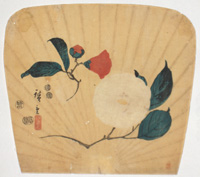
Click here to view image full size.
An ogi-e fan print showing a camellia flower and a magnolia ( ? ) bud and flower. This appears to be the only surviving example of this design having been rescued from an actual fan. Published by Maruya Seijiro, 1852. Excessively rare: Hiroshige only designed a few ogi-e format fans, most being in the round uchiwa-e style. ( For another, see Hiroshige, Matthi Forrer, catalogue of exhibition at Royal Academy of Arts, London, 1997, no. 80. ) Ex Hayashi collection and another unidentified seal au verso.
Good impression and colour. The white camellia blind printed. The fan’s rib marks evident and trimmed to the fan shape. Signed Hiroshige ga.
Status: Sold
Katsushika HOKUSAI (1760-1849)
Click here to view image full size.
Hisui and nadeshiko, kingfisher with pinks and iris from a set of ten chuban prints published c 1832. The first edition ( as here ) was published by and has the seal Eijudo. A later edition is known with combined manji and kiwame seal from different blocks ( some also printed on thin Chinese-style paper ), and there are also impressions extant without any seals which probably constitutes a third state. All impressions are rare and the first state excessively so. Indeed these prints are considered even rarer than the larger bird and flower set Hokusai designed c 1833. The printing and colour on the series comes close to surimono quality. One of the two or three best designs from the set. I have never catalogued this design before or seen another impression for sale. An impression of the second edition is illustrated in Vignier & Inada, 1912, pl. LXXXVII, no. 297. See Hokusai, Richard Lane, 1989, no. 161, p. 296 for a list of the complete set. Each print has a Chinese poem written in hiragana.
Very fine impression and colour. Minor marks and slight trimming, otherwise fine. Signed Zen Hokusai I-itsu hitsu.
Status: Sold
Katsushika HOKUSAI (1760-1849)
Click here to view image full size.
Sekirei and fuji, wagtail and wisteria from a set of ten chuban prints published c 1832. The first edition ( as here ) was published by and has the seal Eijudo. A later edition is known with combined manji and kiwame seal from different blocks ( some also printed on thin Chinese-style paper ), and there are also impressions extant without any seals which probably constitutes a third state. All impressions are rare and the first state excessively so. Indeed these prints are considered even rarer than the larger bird and flower set Hokusai designed c 1833. The printing and colour on the series comes close to surimono quality. Another impression was in my Catalogue 19, 1977, no. 10. See Hokusai, Richard Lane, 1989, no. 161, p. 296 for a list of the complete set. Each print has a Chinese poem written in hiragana.
Very fine impression and colour. Minor marks and slight trimming, otherwise fine. Signed Zen Hokusai I-itsu hitsu.
Status: Sold
Ichiryusai HIROSHIGE (1797-1858)
Click here to view image full size.
Koi, carp ( Cyprinus carpio ). The best design from the second series of Large Fish published by Yamasho, c 1840-42. The first edition, second state ( with the block defect behind dorsal fin evident ). Only the earliest states have the block printing water reeds ( in this case printed blue; other impressions are known with the reeds green ). There is also brown gradation on the belly of the koi on this impression. Rare.
Fine impression. Slight turning of colour at top edge, otherwise good colour and condition. Signed Hiroshige fude.
Status: Sold
Ichiryusai HIROSHIGE (1797-1858)
Click here to view image full size.
Tobiuo, flying fish ( probably Prognichthys ) and Ishimochi also called guchi or shiroguchi, white croaker, ( probably Argyrosomus argenatus ). Together with a single lily. From the second series of fish prints published by Yamasho c 1840-2. Poem by Toshigaki Maharu.
Very good early edition with extensive mica ( Kruml 17, p 36, Andon 49 ). Extra paper at right edge so no trimming of tail. Fine colour ( oxidation on lily ). Fine condition. Signed Hiroshige ga.
Status: Sold
Ichiryusai HIROSHIGE (1797-1858)
Click here to view image full size.
Katsuo, bonito, ( Katsuwonus pelamis ). Also called ocean bonito, strip-bellied bonito and striped tuna. Together with three sprigs of cherry ( sakura ). Poems by Toshinoto Haruki and Toshihiro Machikado. From the first series of fish published by Eijudo c 1832-4.
Very good early edition after the judges’ names removed. ( See Kruml 5, p 16, Andon 49, 1994. ) Fine colour with extensive mica. Slight centre fold ( as usual ). Very good condition. Signed Ichiryusai Hiroshige ga.
Status: Sold
Ichiryusai HIROSHIGE (1797-1858)
Click here to view image full size.
Awabi or tokobushi, abalone or “sea-ear” ( Haliotus tuberculata ) and sayori, Japanese hall-beak or snipe-fish, ( Hemirhamphus sayori ). Together with peach blossom. From the first series of fish prints commercially published by Eijudo c 1832-4. Poems by Kumogaki Fujimi and Miwagaki Mimiki. It’s very difficult to find fine examples of this design, partly because there are deceptive copies and also because the wood blocks may have been softer than the blocks used for other prints from the set. Hence impressions are often poor.
Very good early impression. Between the first private edition and the early commercial edition: Lacking judges’ names but before kiwame and Eijudo seals. ( See Kruml 6a and 6b, p 17, Andon 49, 1994. ) Fine colour. Very good condition. Signed Ichiryusai Hiroshige ga.
Status: Sold
Ichiryusai HIROSHIGE (1797-1858)
Click here to view image full size.
A madai, red tai or red seabream with sprigs of sansho ( Japanese pepper ). From the first set of fish prints published by Eijudo, 1832-34. Two Kyoka poems by Shizugaki Namiyasu and Toshigaki Maharu.
Good impression, colour and condition. Heavy use of mica. Signed Ichiryusai Hiroshige ga.
Status: Sold
